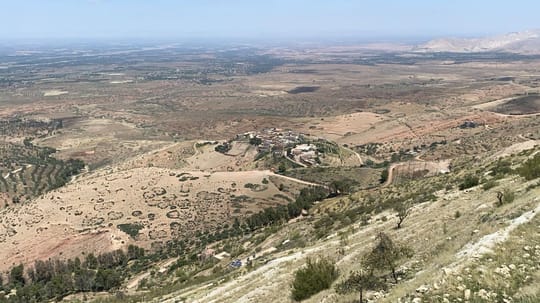Tales of Ancient Amazigh Beauty, Art and Poetry

Nestled in the embrace of the High Atlas Mountains, the village of Talat-n-Mimoun is not simply home to 210 people, but a center of Amazigh beauty, art and poetry. This village, removed from the hustle and bustle of the cities, harmonizes the natural beauty of the mountains with the spirit of the Amazigh people; the original inhabitants of North Africa. Their regions range from the towering Atlas Mountains to the vast Sahara to the Mediterranean and Atlantic coasts; environmentally and culturally diverse.
The women of Talat-n-Mimoun are distinguished by their captivating beauty which blends tradition with modernity, representing a rich cultural heritage passed down through generations. Amazigh beauty knows no bounds; it is evident in every detail of life and in the faces of all the village residents. Their daughters are adorned with traditional colorful dresses and intricately crafted silver jewelry, bearing engravings and decorations that narrate a long and rich history. The traditional attire, distinguished by its bright colors and handcrafted embroidery, tells the stories and traditions of their ancestors.
Whilst delivering a Psychosocial Empowerment workshop in the village, I was struck by the appearance of a young girl with Western features: eyes as blue as the sky and golden silk-like hair. This girl piqued everyone's curiosity, raising questions about her origin and whether she was of Western descent. To our surprise we learned that her roots were deeply Amazigh. She is not merely a beautiful face, but a daughter of this ancient culture, embodying the stunning and diverse beauty of the Amazigh people which blends the allure of the West with the authenticity of the East.
This girl carries within her an ancient history and radiates the Amazigh spirit. She offers us a lesson in tolerance and acceptance of others, reminding us that true beauty lies in the diversity and plurality that adorn our lives and distinguish us as humans. She proves that beauty is not only confined to specific features but extends through the ages, manifesting in every detail of life. She represents a cultural identity that has been preserved across centuries.
During our time in Talat-n-Mimoun, we sat with the women, sipping tea infused with the bounty of nature, the scent of wild herbs filling the air. These moments were filled with warmth and intimacy, as if time stood still, allowing us to live in an extended present whilst listening to the tales of the past. The elderly women were like hidden treasures, carrying within them a long history of folk songs and traditional chants passed down through generations. Each of them narrated a part of their sonic memory, their melodious voices flowing freely, carrying notes of longing, hope, and strength.
When they sang, their words danced in the air, intertwining with the breeze and sounds of nature, to create a harmonious symphony that expressed the spirit of the Amazigh people and the depth of their culture. The free voice of Amazigh women, flowing with depth and emotion, does not merely recount past tales but reflects the present with all its challenges, along with future dreams. Their songs mirrored daily life in the village, with its simple details, joys, sorrows, and the nuances of love, friendship, and resilience against the changes of time.
In those moments, there was no barrier between us and them; just deep human connection. Each song carried a story, and each melody held unforgettable memories. When one of the women sang about love, we felt our hearts racing, and her voice took us on a journey through time. When another sang about separation, we felt sorrow creeping into our hearts, as if we were parting with loved ones and embarking on a journey into the unknown. Their voices harmonized with the surrounding nature as if the earth itself enjoyed and participated in this vocal celebration; the mountains echoing their songs and the valleys carrying their melodies to distant places. We sat in silence, captivated by the beauty of the moment, immersed in the depth of meanings and emotions carried by the songs.
This time spent with the women of Talat-n-Mimoun reinforced the power of art and poetry. Each melody conveyed a story of courage; a lesson from the past for the future. These stories have the power to heal; providing strength and hope. Their words carried messages of wisdom and patience, demonstrating how one could face difficulties with a smile and faith. Their voices spoke of past and future generations who would continue this rich heritage. The value and importance of preserving this Amazigh beauty became clear.